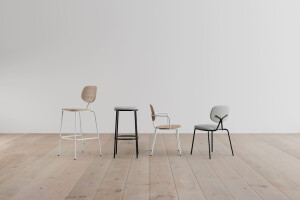The ‘Seamless’ furniture collection for Established & Sons represents the result of Zaha Hadid Architects’ exploration into a world of seamless fl uidity. It is a built manifesto towards the potential for a new language of design and architecture, which is driven by the latest in digital design processes and the most cutting edge manufacturing techniques. With the overall conception of the designs ultimately driven by the new possibilities created by signifi cant technological advancements in three dimensional design software, as well as our inherent desire to test and engage with the very latest manufacturing capabilities, the resulting collection of furniture is a dialogue of complex curvilinear geometries and detailed ergonomic research that provides the opportunity for us to reinvent the balance between furniture and space. These unique pieces are an obvious evolution of the architectural language explored by the practice: soft meets sharp, the combination of convex and concave, and a sculptural sensibility that impact on our self-conception as bodies. The rhythm of folds, niches, recesses and protrusions follows a coherent formal logic. With the formal dynamic of a fl uid mass, we are able to emphasize the continuous nature of the design and the smooth evolution between otherwise disparate elements. The evolutionary lineage of the pieces is easily discernable through re-visitation of past projects such as Z-Scape (2000), Ice Storm (2003), Aqua Table (2005), the Hotel Puerta America interiors (2005) and Elastika (2006). Seamless represents the culmination of this morphological series and a new beginning in terms adding new surface sensations.
The design language explored within this collection of pieces emphasizes the usage of complex curvelinearity, seamlessness and the smooth transition between elements. A formal integration of diverse forms allows individual furniture pieces to be considered within the overall mass of the ensemble. Whilst individual elements are nevertheless morphologically affi liated, they can be read not only as a whole, but as loose fragments that drift around the scene as if captured in a magnetic fi eld. The pieces, initially morphologically conceived, are shaped further by typological, functional and ergonomic considerations. However these further determinations remain secondary and precariously dependent on the overriding formal language of the collection. A margin of strangeness invites a stimulation that has evolved between the morphogenetic logic and adaptations with regard to functional affordances.
















